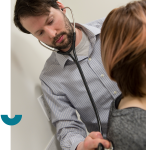Under Review: No
Issued by Council (Sexual Boundary Violations): January 1, 2010
Reissued by Council (Boundary Violations): July 1, 2018
Reissued by Council (Boundary Violations: Personal): April 1, 2019
Please refer to both this and the Boundary Violations: Sexual standard for all expectations related to boundary violations.
Physician-Patient Relationship
- A regulated member must maintain professional boundaries in any interaction with a patient including, but not limited to:
- providing adequate draping:
- providing privacy while the patient is undressing or dressing;
- obtaining informed consent for intimate or sensitive examinations; and
- using appropriate examination techniques when touching sensitive or personal areas of the body including, but not limited to, breasts, genitalia or anus.
- A regulated member must consider and minimize any potential conflict of interest or risk of coercion when engaging with a patient in a non-clinical context (i.e., in a personal, social, financial or business relationship).
- A regulated member must not:
- enter into a close personal relationship with a patient or any person with whom a patient has a significant interdependent relationship (e.g., parent, guardian, child or significant other);
- socialize or communicate with a patient for the purpose of pursuing a close personal relationship; or
- terminate a physician-patient relationship for the purpose of pursuing a close personal relationship.
- A regulated member must not enter into a close personal relationship with a former patient unless:
- the regulated member has never provided the patient with psychotherapeutic treatment;
- there is minimal risk of a continuing power imbalance; and
- sufficient time has passed since the last clinical encounter, given the nature and extent of the physician-patient relationship.
- A regulated member must not promote his/her personal or religious beliefs or causes to a patient in the context of the physician-patient relationship.
Physician-Learner and Physician-Subordinate Relationships
- A regulated member must not:
- sexualize a teacher-learner relationship by making sexual comments or gestures toward a learner1;
- enter into a close personal or sexual relationship with a learner while directly or indirectly responsible for mentoring, teaching, supervising or evaluating that learner; or
- enter into any relationship with a learner that could present a risk of conflict of interest or coercion while directly or indirectly responsible for mentoring, teaching and/or evaluating that learner.
- A regulated member who has a pre-existing (current or past) close personal or sexual relationship with a learner or a subordinate physician must:
- notify the applicable clinical and academic leaders of the relationship;
- remove him/herself from any role teaching or evaluating the subordinate physician or learner; and
- remove him/herself from any discussion of the performance of the subordinate physician or learner.
1.“Learner” includes, but is not limited to, clinical trainee, medical student, other health professional learner, graduate student, resident or fellow.
Advice to the Profession
All ResourcesRelated Standards of Practice
All ResourcesBoundary Violations: Sexual
CPSA Click to view filesCode of Ethics & Professionalism
CPSA Click to view filesConflict of Interest
CPSA Click to view filesDuty to Report a Colleague
CPSA Standard of Practice Click to view filesInformed Consent
CPSA Click to view filesTerminating the Physician-Patient Relationship
CPSA Click to view filesQuestions?
For questions or archived standards, policies and guidelines contact our Standards of Practice Advisor.
























